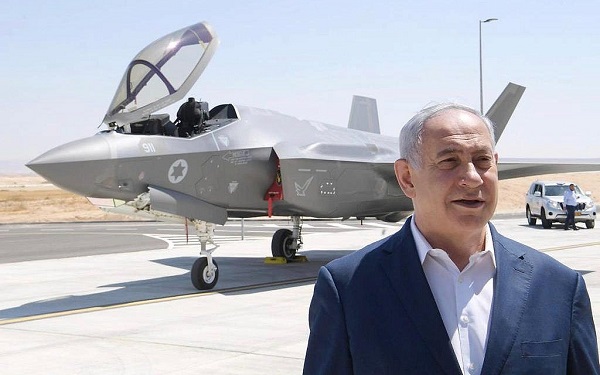Alwaght- While the tensions between Washington and Tehran relatively began to de-escalate and the Americans call for unconditional negotiations as the US administration walks back from its aggressive approach to Iran especially after Iran’s shooting down of an American spy drone that violated the Iranian airspace in the Persian Gulf, the Israeli Prime Minister Benjamin Netanyahu has threatened Iran militarily saying that Tel Aviv could launch preemptive airstrikes on targets in Iran. While visiting an air force base where he inspected F-35 jets made by US firm Lockheed Martin, Netanyahu issued a video with one of the planes behind him.
"It would do well to remember that these planes can reach anywhere in the Middle East, including Iran and certainly Syria."
Israeli F-35s
The F-35s are the fifth generation of the fighter jets made by the US under a costly project in three models of A, for conventional takeoff and landing, B, for horizontal takeoff and landing, and C, customized for the navy. The stealth fighter’s first test flight was made in 2006. The Israelis in 2010 signed a pact with Lockheed Martin to buy 50 of them. In December 2016, the first batch was delivered to the Israeli air force. In June 2017, Israeli National News website reported that so far the Israeli air force received several jets from its new fighter squadron and it appears that the Israeli leaders consider placing an order for another 50.
The model sold to the Israeli regime is dubbed “Adir”, which got special coverage in the media. Tel Aviv demanded the use of some of the domestically-developed systems in the jets. Initially, the American firm resisted the call but at the end of the road it agreed with the demand. Each F-35 costs about $110 million.
The Israeli military officials in June 2018 announced that for the first time in the world they used the newly-delivered F-35s in real-life military operation. Tel Aviv claimed that the operation was carried out in Syria and despite Syrian air defenses fired “hundreds” of surface-to-air missiles in response, the planes struck their targets and returned to their airbases safely without any damage.
It seems that this operation has given the Israeli PM the motivation to threaten Iran with F-35-launched airstrikes as they can reach anywhere in the region. Now the question is can these jets be effective in an anti-Iranian attack?
Earlier, the Israeli National News website enumerated some of the jet’s major flaws arguing that these aircraft cannot carry out air raids without being detected by radars as they are claimed to be stealth. The first problem, the Israeli news outlet suggests, is the high sound these jets make, something making its discovering easy. The only thing Iran needs to do to detect the Israeli aircraft is to keep vigilant the civilians living in border areas.
Another weak spot according to the Israeli website is its sound difference from different other aircraft. So, all of the residents of the Negev region, a desert in the south of occupied territories, who are not loyal to Tel Aviv can detect the F-35s and report their flight to Iran, the website adds.
Furthermore, if a number of Iranian fighter jets are scrambled to intercept, the F-35s pilots can lose in a dogfight. The Israeli F-35s can fly faster than some Iranian fighters but they can hardly be faster than Iranian F-14 Tomcats or other models.
Another challenge can be posed by a question: Can they really enter the Iranian airspace without being detected by the Iranian air defense systems? The F-35s are boasted of for having systems making them stealth. But are they really capable of hiding from advanced air defenses?
The aircraft, manned or unmanned, being stealth is now a serious obsession for the manufactures and operators as now the air defenses and radars are highly capable of detecting and engaging many of the aircraft.
Essentially, no country can claim that it made a 100 percent-stealthy aircraft. The competition is, in fact, on the degree of hiding from the radars.
Any airplane or any other object has a volume that is visible to the radars through its radar cross-section (RCS). The race today is over the RCS. The smaller RCS range the harder detection of the aircraft.
Iran air defense sports high-accuracy radars including the S-300, Nebo, Kasta 2E, the home-developed Raad and some of the other domestically-made radars. They enable it to detect and track aircraft and missiles. In December 2011, Iran detected the cutting-edge RQ-170 spy drone, took its control by hacking its navigation systems and landed it safely into its territory. On June 25 Iranian air defense Raad detected and shot down Global Hawk spy drone of the US navy upon its violation of Iranian airspace over the Strait of Hormuz. In addition to its high surveillance capabilities, the Global Hawk was claimed to be highly stealthy in operations. It fell victim to an Iranian air defense missile, however.
Netanyahu’s objectives
Given the small chances of the F-35s remaining hidden from the Iranian air defenses and also the high risks of anti-Iranian military action that triggers bigger risk to the Israeli regime’s very territorial existence, it seems that Netanyahu’s comments are symbolic and largely meant for home consumption.
The Israeli leader, along with Saudi Crown Prince Mohammed bin Salman and UAE Crown Prince Mohammad bin Zayed, has been pushing for a US-Iranian war. Now Frustrated to see no confrontation especially after Iran downed the spy drone that made Trump largely rethink his hostile rhetoric against Iran, Netanyahu resorts to a show of threats as Iran begins the second step of reducing its nuclear commitments amid American inaction.
As the Israeli regime heads to the general election, Netanyahu struggles to channel the votes towards the right-wing parties by promoting the phobia of a nuclear Iran and label himself the only man can seriously face this made-up threat.



























